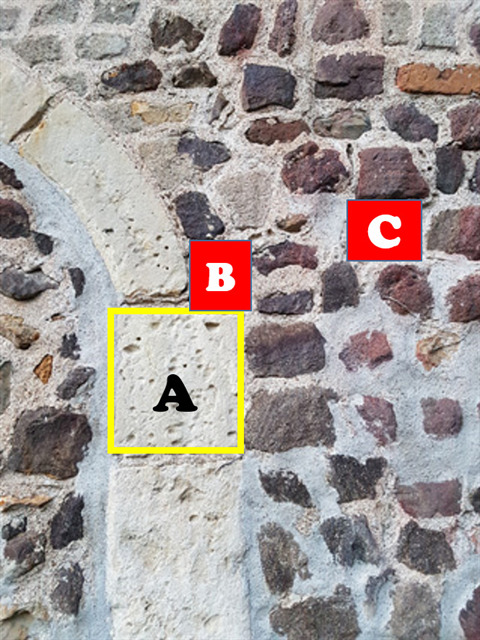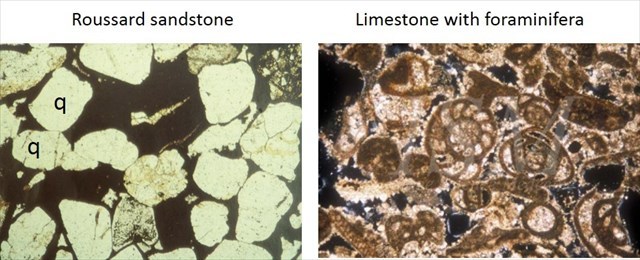

L’église de Marray est le seul édifice religieux de Touraine comportant du grès roussard. Cette pierre est ici associée à une autre pierre sédimentaire, le tuffeau, qui est largement répandu dans les édifices de notre région (Châteaux de la Loire, cathédrale Saint Gatien de Tours, abbaye de Fontevraud…). Le grès a été utilisé dans les murs du bâtiment tandis que le tuffeau a été utilisé pour les contreforts de l’église, le portail et les fenêtres. L’origine du bâtiment remonte à la fin du XIème siècle et l’utilisation de moellons irréguliers de grès roussard a été rendue possible par la présence d’une carrière proche aujourd’hui disparue.
Ce grès roussard provient de deux événements géologiques : tout d’abord, le dépôt au Cénomanien (il y a environ 100 millions d’années) de sables dans une mer peu profonde puis dans un deuxième temps à l’époque Eocène (il y a environ 40 millions d’années), l’alternance de saisons humides et sèches liées à un climat tropical a entrainé lors des fortes précipitations, la dissolution de la silice contenue dans les sables. En saison sèche, l’eau saturée s’est évaporée et la silice contenue dans la boue a formé un ciment qui a aboutit à la formation de grès en surface.
Le nom du grès roussard provient de sa couleur tirant sur le rouge car il s’agit d’un grès ferrugineux. Vous remarquerez que certaines pierres présentent une couleur plus foncée virant sur le noir, cette coloration est due à la présence d’oxyde de manganèse. Les sables ferrugineux associés aux grès roussard ont une couleur jaune ocre. Ils ont ici été utilisés pour les enduits de plusieurs bâtiments anciens que vous pourrez apercevoir à proximité de l’église.
Pour ce qui est du tuffeau, son origine géologique est plus récente (Crétacé supérieur, étage Turonien de l’ère mésozoïque, il y a environ 90 millions d'années). Il s’est formé par sédimentation de particules fines d’origines animales et minérales qui ont subi un tassement qui par pression a permis leur recristallisation et leur cimentation. Le tuffeau est une pierre plus tendre que le grès roussard ce qui rend son utilisation plus facile pour la construction et pour la sculpture.
Au microscope, les grès roussards (Image: G. Cattaneo, Université du Mans) présentent des particules de quartz (blanc) liées entre elles par un ciment (d’aspect plus sombre) tandis que les calcaires peuvent présenter des profils plus hétérogènes dus à une grande hétérogéneité des fragments minéraux et animaux qui les composent (Image: H. Conge, ISM).

Loguez cette cache "Found it" et envoyez-moi vos propositions de réponses soit via mon profil, soit via la messagerie geocaching.com (Message Center), et je vous contacterai en cas de problème.
Rendez vous au WP1, et cherchez l’ancienne porte romane sur le mur latéral :

1) Combien de millions d’années séparent la pierre A des pierres B et C ?
2) Décrivez la pierre B et la pierre C. Selon vous quelles sont leurs compositions respectives ?
Au WP2, cherchez la pierre D .

3) De quel type de « roche » s’agit il ? Selon vous d’où provient-elle ?
4) Ajoutez une photo de vous ou d’un objet vous identifiant devant le porche de l’église.

The chuch of Marray is the only religious building in Touraine made of "roussard" sandstone. That stone is here associated with chalkstone locally named "tuffeau" that was thoroughly used in famous buildings (Loire Castles, St Gatien's cathedral in Tours, Fontevraud abbey...). Sandstone was used in the walls of the building while tuffeau was used for the buttresses of the church, the portal and the windows. The origins of the building date back to the end of the 11th century and the use of irregular sandstones was made possible by the presence of a nearby quarry which has since disappeared.
This russet sandstone comes from two geological events: first, the Cenomanian deposit (about 100 million years ago) of sands in a shallow sea and then in the second time , the alternation of wet and dry seasons during the Eocene era (approximately 40 million years ago) linked to a tropical climate led during heavy precipitation to the dissolution of the silica contained in the sands. In the dry season, the water saturated with silica evaporates allowing the silica to form a cement and therefore to form sandstones on the surface. The name of russet sandstone comes from its reddish color because it is a ferruginous sandstone. You will notice that some stones have a darker color turning black, this coloration is due to the presence of manganese oxide. The ferruginous sands associated with russet sandstone have an ocher yellow color. They were used here for the plastering of several old buildings that you can see near the church.
As for the tuffeau, its geological origin is more recent (Upper Cretaceous, Turonian stage of the Mesozoic era, about 90 million years ago). It was formed by sedimentation of fine particles of animal and mineral origin which underwent a compaction which by pressure allowed their recrystallization and their cementation. Tuffeau is a softer stone than russet sandstone which makes its use easier for construction and for sculpture.
Under a microscope, roussard sandstones (image from G. Cattaneo, Univ. of Le Mans) have quartz particles (white, q) bonded together by a cement (darker in appearance), while limestones may present a larger heterogeneity associated with a wide range of mineral and animal fragments (Image: H. Conge, ISM).

Log this cache "Found it" and send me your replies via my profile or via geocaching.com (Message Center). I will contact you in case of problem.
Go to WP1, and look for the old Romanesque door on the side wall:

1) How many millions of years separate stone A from stones B and C?
2) Describe stone B and stone C. According to you what are their respective compositions?
At WP2, look for stone D.

3) What type of "rock" is it? Where do you think it comes from?
4) Post a picture of you or of one of your belongings (with username identification) in front of the church main entrance.